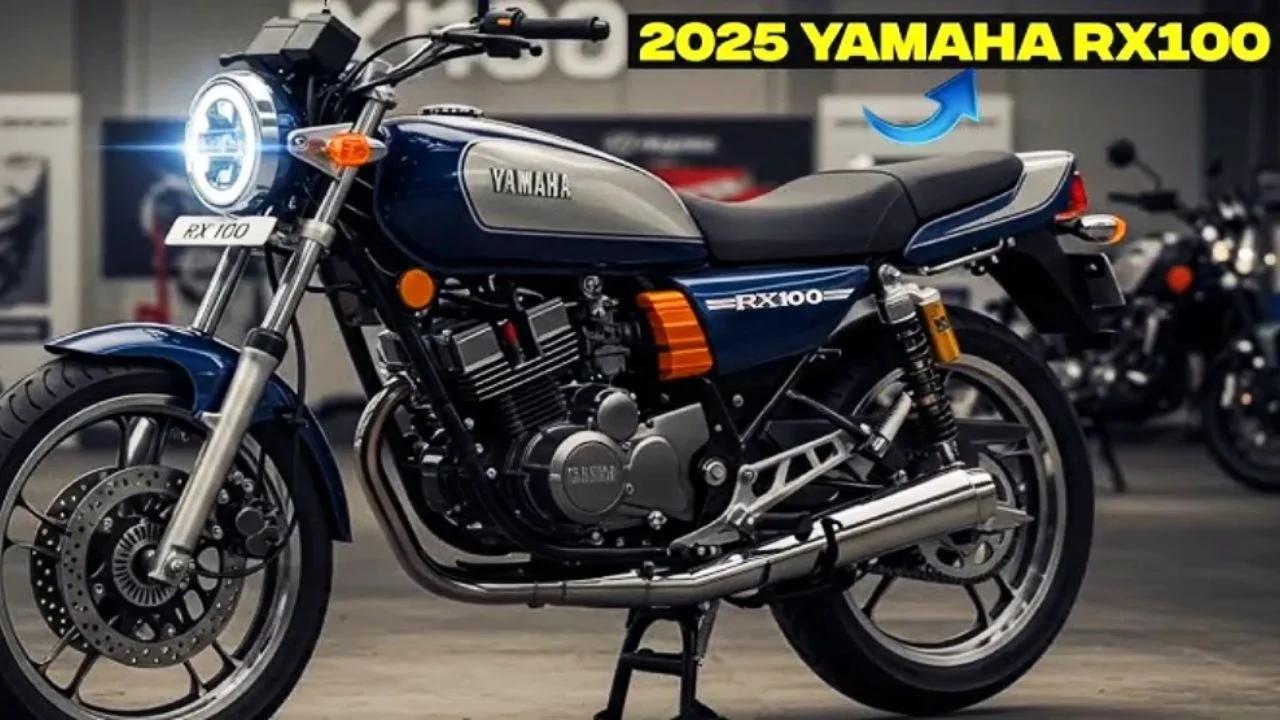In the world of motorcycles, some bikes are not just vehicles; they are symbols of an era. One such iconic machine is the Yamaha RX100. Launched in 1985, the RX100 became a legend in India, captivating riders with its performance, design, and unique mechanical charm. Though it was discontinued in 1996, the RX100 continues to have a cult following, and its memory still lives in the hearts of motorcycle enthusiasts across India. In this deep dive, we explore the timeless appeal of the Yamaha RX100, a bike that changed the way Indians viewed two-wheelers.
Yamaha RX100 – Key Specifications at a Glance
| Feature | Details |
|---|---|
| Engine | 98cc, air-cooled, 2-stroke |
| Power Output | Approx. 11 HP |
| Transmission | 4-speed manual gearbox |
| Weight | Around 100 kg |
| Top Speed | Nearly 100 km/h |
| Brakes | Front & rear drum brakes |
| Fuel Efficiency | 25–30 km/l |
| Suspension Setup | Telescopic forks (front), twin shock absorbers (rear) |
| Production Years | 1985–1996 |
| Legacy | Lightweight, powerful, and iconic |
The Dawn of an Icon
When the Yamaha RX100 debuted in 1985, the Indian two-wheeler market was largely dominated by underpowered, fuel-efficient motorcycles designed primarily for commuting. At the time, bikes were largely practical, offering minimal excitement or thrill. Enter the RX100—a 100cc motorcycle that shattered stereotypes and changed everything.
Unlike its contemporaries, the RX100 was built for performance. Powered by a 2-stroke engine, it offered explosive acceleration and a thrilling ride. With a top speed approaching 100 km/h, the RX100 was fast—faster than any other 100cc bike on the market. It had a lightweight frame, an aggressive throttle response, and a feather-light body, which combined to make it one of the most exhilarating motorcycles of its time.
The Sound of Rebellion
One of the most defining features of the Yamaha RX100 was its unmistakable exhaust note. That sharp, raspy growl became an iconic sound—a soundtrack for those who craved freedom, speed, and rebellion. It wasn’t just noise; it was the voice of a generation of riders who wanted something more than just a commuter bike. Whether zipping through city streets or cruising on open highways, the RX100 turned heads and stirred emotions.
In an era where motorcycles didn’t speak, the RX100’s engine growl said everything—it was a statement of power, freedom, and individuality. For many, riding the RX100 was less about getting from point A to point B, and more about the adrenaline rush and the joy of the ride.
Light, Nimble, and Incredibly Fun
When it came to handling, the RX100 was in a class of its own. Weighing just around 100 kg, it was lightweight and incredibly nimble. Whether weaving through busy traffic or taking sharp turns, the RX100 felt like an extension of the rider’s body. It wasn’t just a machine; it was a partner that adapted to every twist of the throttle.
The bike’s ergonomic design made it suitable for riders of all sizes and skill levels. Young riders especially found the RX100 to be a playful and forgiving companion, one that made every ride feel like an adventure. Its low center of gravity, peppy engine, and responsive handling made it ideal for both city riding and spirited bursts on open roads.
A Design That Stood the Test of Time
While modern motorcycles today are full of sharp edges, digital displays, and flashy decals, the Yamaha RX100 thrived on simplicity. It had a compact, muscular fuel tank, a single round headlamp, chrome-finished mudguards, and a lean stance. Every design element had a purpose—there was no excess, just a raw, minimalist approach that emphasized function.
Its aesthetic appeal continues to inspire custom builders and restoration experts who try to preserve or recreate the RX100’s classic look. Despite being decades old, the RX100 still has a timeless charisma that few bikes can match.
Mechanical Excellence in Simplicity
Though the Yamaha RX100 lacked the advanced technology found in modern motorcycles, its mechanical simplicity was a big part of its charm. There was no fuel injection, no ABS, and no electronic gadgets—just a solid, well-engineered 2-stroke engine that was easy to maintain and modify.
Tinkering with the carburetor, cleaning the exhaust, and replacing spark plugs became regular rituals for owners. The 4-speed manual gearbox was smooth, and its gear ratios were perfect for rapid acceleration. With telescopic forks at the front and twin shock absorbers at the rear, the suspension provided a decent balance of comfort and performance. The drum brakes, though outdated by today’s standards, were effective in bringing the lightweight bike to a halt.
In essence, the RX100’s mechanical purity made it reliable, easy to repair, and fun to ride—a quality that still resonates with enthusiasts today.
A Cult Following That Never Died
Though production of the Yamaha RX100 ceased in 1996, its legacy lived on. Across India, you’ll find dedicated workshops specializing in restoring and customizing RX100s. Online communities and social media groups buzz with discussions about restoring, upgrading, and preserving the RX100. For many, the RX100 isn’t just a bike; it’s a way of life—an object of nostalgia and passion.
Original, well-maintained models are highly sought after by collectors. A restored RX100 can fetch prices ranging from ₹80,000 to ₹1.5 lakh, which is a significant jump from its original price tag of less than ₹20,000.
The RX100 in Indian Motorsports
The Yamaha RX100 also made its mark on the Indian motorsports scene. In the late 80s and early 90s, the RX100 became a staple at drag races and amateur racing circuits. Tuners would push the engine beyond its factory specifications, adding performance mods like expansion chambers and performance carbs to extract even more power.
It wasn’t uncommon to see RX100s outperforming bikes with larger engines, thanks to their lightweight frame, explosive acceleration, and precise handling. Even today, modified RX100s continue to participate in retro racing events across India, keeping the spirit of the bike alive.
Will the Yamaha RX100 Make a Comeback?
Rumors and speculation about a Yamaha RX100 revival have been swirling for years. Modern emission norms, safety regulations, and customer expectations would need to be addressed, but the possibility of a retro-themed RX100 or a performance-oriented lightweight bike has excited many loyalists. If Yamaha decides to bring the RX100 back, it will undoubtedly draw attention from both nostalgic riders and new-age motorcycle enthusiasts.
The Yamaha RX100 was not just another motorcycle; it was a revolution. It changed the way Indians viewed motorcycles and pushed the boundaries of what a 100cc bike could achieve. Whether it was for young college students, seasoned racers, or first-time riders, the RX100 touched lives and created lasting memories.
Even today, its legacy continues. From garages to racing pits and collector homes, the RX100 remains a powerful symbol of freedom, adventure, and unfiltered joy. If you ever get a chance to ride one, take it. Because in that ride, you’re not just experiencing a motorcycle—you’re tapping into a piece of history.
FAQs
Why was the Yamaha RX100 discontinued?
The RX100 was discontinued due to tightening emission regulations in the mid-90s. The 2-stroke engine couldn’t meet new environmental standards, leading Yamaha to focus on 4-stroke models.
Can you still buy a Yamaha RX100 today?
While no new models are being produced, you can still find restored or used RX100s in the second-hand market. However, original models in good condition are becoming rarer and more expensive.
Is the Yamaha RX100 suitable for daily use today?
Yes, but regular maintenance is required due to its age. Finding authentic parts can be challenging, and the bike may need frequent repairs.
Why was the RX100 considered so fast?
Its 2-stroke engine offered quick torque delivery and a low weight, giving it an excellent power-to-weight ratio, making it faster than many of its contemporaries.




